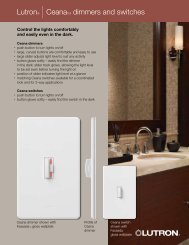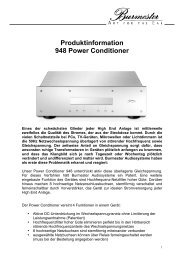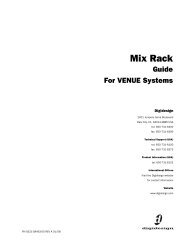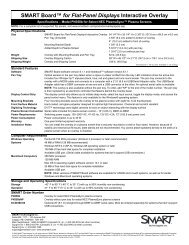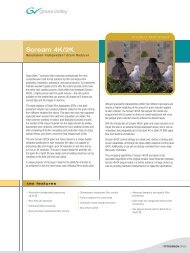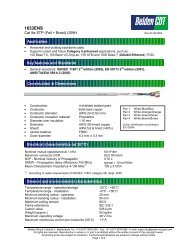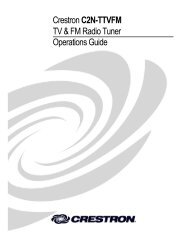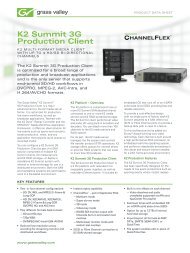Quickfly Operating Manual - Meyer Sound Laboratories Inc.
Quickfly Operating Manual - Meyer Sound Laboratories Inc.
Quickfly Operating Manual - Meyer Sound Laboratories Inc.
You also want an ePaper? Increase the reach of your titles
YUMPU automatically turns print PDFs into web optimized ePapers that Google loves.
Figure 2<br />
Note: Short connecting bars can be used in front in<br />
horn coupled configurations (no vertical<br />
splay). See the Appendix for more examples.<br />
4.3 SIMPLE SYSTEM EXAMPLES<br />
Figure 2, above, shows four MSL-6 cabinets flown in a configuration<br />
that will give 60 degrees horizontal coverage by<br />
13 degrees vertical coverage. Figures 7 and 8 on Page 8<br />
show two Type 4 loudspeakers attached to the Type 6 MSL-<br />
6 via 8 SLC-1 connecting chains. Each MSL-6 is fitted with<br />
an MRF-6 rigging frame on its top and bottom. The MRF-6<br />
is attached to the lifting motor set via a 5/8" (or larger)<br />
shackle through one of the lifting points located along its<br />
central structural member.<br />
4.4 ATTACHING THE MRF-6 TO A TYPE 6 PRODUCT<br />
The MRF-6 rigging frame attaches to a Type 6 loudspeaker's<br />
internal steel rigging structure (See Section 4.5) through<br />
the cabinet’s existing rigging attachment points. Tools<br />
required are a ratchet with a 1/4" allen bit and a 1/2"<br />
socket, and a caulking gun. This procedure takes 20 to 30<br />
minutes. Using the 1/4" allen bit, remove all six of the<br />
existing pivoting lifting rings from the cabinet. (Figure 3)<br />
The rings will be replaced; set them nearby.<br />
Figure 3<br />
Using a caulking gun, place a small amount of silicone<br />
evenly over each hole just prior to positioning the frame<br />
onto the cabinet (Figure 3).<br />
7<br />
Note: The holes must be resealed using the included<br />
silicone sealant (GE IS800 series) to avoid creating<br />
air leaks from the cabinet's airtight chambers.<br />
Immediately after applying the silicone, return the triangle<br />
rings and the round blocks to their proper places on the<br />
cabinet. Be careful to position them over the mounting<br />
holes so that the thread path of each mounting bolt<br />
remains unobstructed. Place the MRF-6 aluminum frame on<br />
the cabinet, positioning it over the mounting holes (Figure<br />
4). Be careful not to change the position of the rings and<br />
round blocks.<br />
Figure 4<br />
Using a 1/2" socket and the hardware provided, attach the<br />
MRF-6 to the cabinet (Figure 5).<br />
Figure 5<br />
5/16 Bolt<br />
5/16 Locking washer<br />
5/16 Washer<br />
Alignment with all twelve holes on the cabinet is easiest if<br />
you start by first hand-tightening the bolts through the<br />
front inner lifting rings, proceeding next to the rear lifting<br />
ring locations and finish with the front outer locations.<br />
Once the bolts are hand-tightened, torque each of them<br />
down as evenly as possible to avoid any possible damage<br />
to the cabinet. The bolts should be torqued to 10-20 ftlbs.<br />
Care should be taken to avoid cross threading or overtightening<br />
the bolts. Although locking washers are used,<br />
the bolts always should be inspected prior to use in a<br />
flown system. Ensure that all bolts are properly tightened<br />
and evenly secure the frame to the cabinet.




